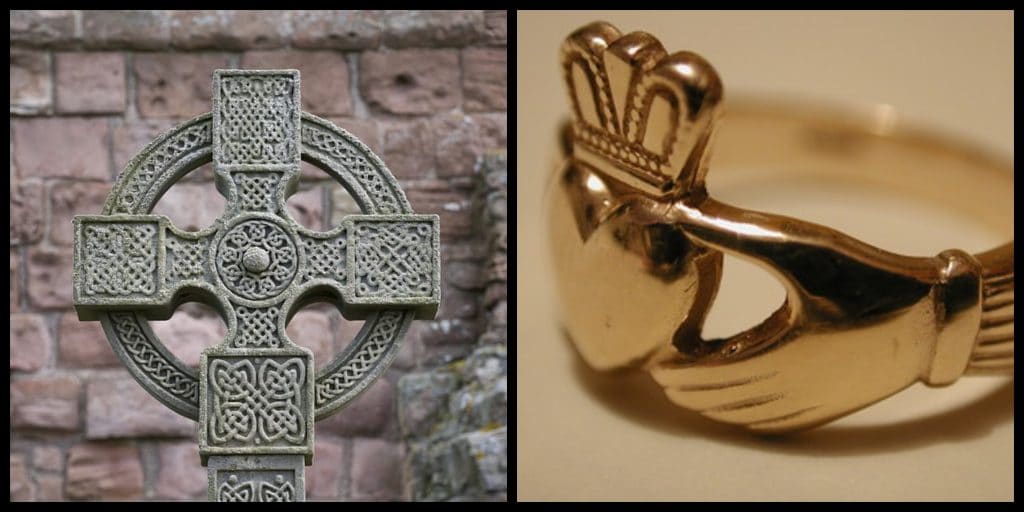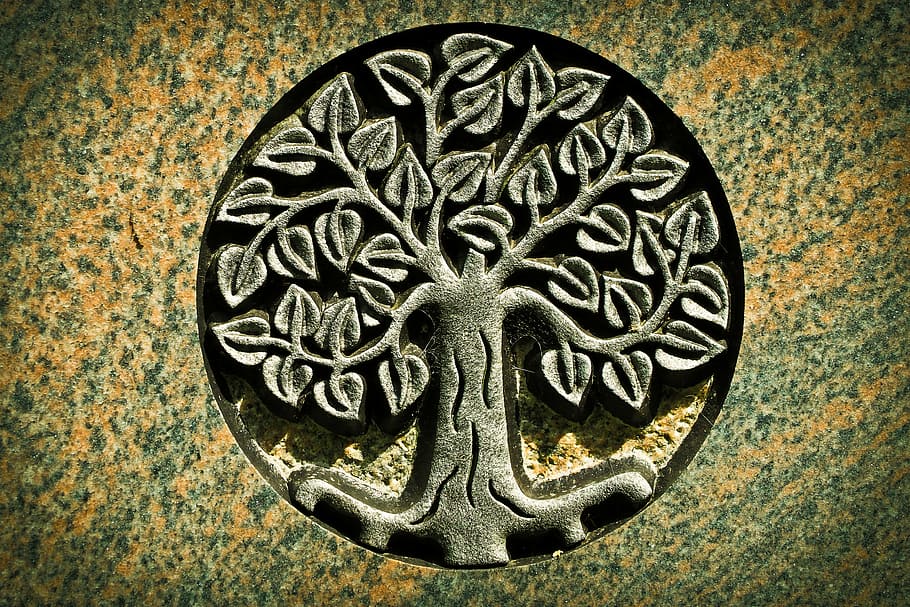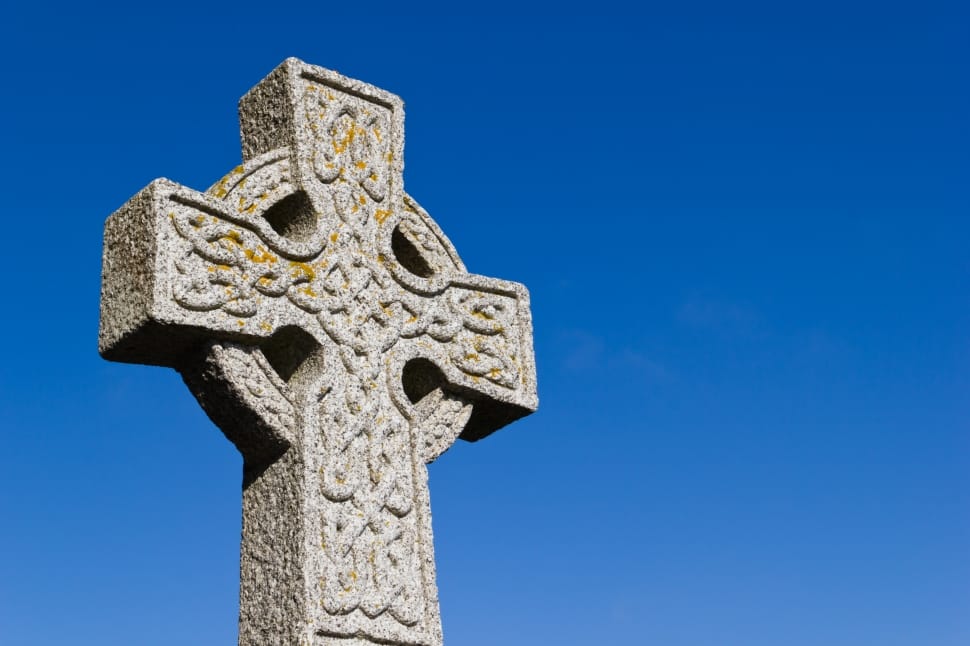Delve into the fascinating culture and history of Ancient Ireland, with our list of the top 10 Irish Celtic symbols and their meanings.

Interest in Irish Celtic symbols and their meanings has grown massively in recent years. From tattoos that reconnect people with their Celtic heritage, to wedding bands crafted in their likeness, people all over the world are showing a desire to incorporate these ancient symbols into their lives today.
But what do these mysterious symbols mean? We’ve taken some of the most popular and enduring symbols of Irish Celtic times and broken them into this handy guide, below.
- Delve into the fascinating culture and history of Ancient Ireland, with our list of the top 10 Irish Celtic symbols and their meanings.
- Meanwhile in Ireland’s top facts about Irish Celtic symbols
- 10. The Green Man – the Celtic celebration of Bealtaine
- 9. The Awen of the Three Rays of Light – symbolising duality and harmony
- 8. The Tree of Life – Celtic wisdom and power
- 7. Brigid’s Cross – for the return of Spring
- 6. Dara Knot – one of the best Celtic symbols
- 5. The Celtic Cross – for the four sacred elements
- 4. The Triskele – represents the sacred trios
- 3. The Triquetra – for eternal spiritual life
- 2. The Claddagh – representing love, friendship and loyalty
- 1. The Shamrock – a Celtic symbol synonymous with Ireland
- Your questions answered about the top Irish Celtic symbols and their meaning
Meanwhile in Ireland’s top facts about Irish Celtic symbols
- Celtic symbols and their meaning go back in history for over thousands of years, forming part of ancient Celtic culture across Ireland and different parts of Europe.
- Spirals are a frequent Celtic symbol in its art. It is said to represent the journey of life with no beginning or end.
- The Celtic knot is one of the most famous Celtic symbols. Again, they also have no beginning or end, illustrating the eternity of life.
- The Claddagh ring is a very popular piece of Celtic jewellery that is sold widely across the Emerald Isle. Its two hands holding a heart with a crown symbolise love and loyalty.
- Celtic art often also represents different animals, such as the boar, raven and stag, each of which have their own symbolic meaning and representation.
10. The Green Man – the Celtic celebration of Bealtaine

You might recognise this mysterious green face, peaking out of fertile foliage from buildings across Ireland and Britain.
This ancient symbol is particularly associated with May, and the Celtic celebration of Bealtaine. It symbolises the return of green to the trees and summer in the air.
9. The Awen of the Three Rays of Light – symbolising duality and harmony

This beautiful symbol has neo-Druid origins. The two outer rays represent the duality of masculine and feminine energies, while the ray at the centre symbolises the places where they meet.
It is said to symbolise duality and harmony of opposites in the universe, and is one of the most fascinating Irish Celtic symbols.
8. The Tree of Life – Celtic wisdom and power

Trees have been a huge influence in ancient spirituality and philosophy across the world, but they held a special significance in Irish Celtic tradition.
Seen as symbols of great wisdom and power, the Tree of Life symbol is said to represent balance and harmony.
7. Brigid’s Cross – for the return of Spring

Many Irish folk will associate this symbol with the Christian Saint Brigid of Kildare, but this symbol actually pre-dates Christianity in Ireland. A similar symbol was previously constructed with rushes to honour Brigid, the pagan goddess of spring.
So loved by the ancient people of Ireland was this goddess, that it appears she couldn’t be completely eradicated from Irish life, and so she was transformed into the Saint many know today.
This symbol represents hope, life-giving and the return of the spring.
Read: St Brigid’s Cross: the meaning and history of the Irish symbol
6. Dara Knot – one of the best Celtic symbols

This stunning symbol is said to represent power, bravery and wisdom, making it an extremely unique Celtic symbol.
These same virtues were attributed to the Oak Tree, which is ‘doire’ in Gaelic, and from where this symbol gets its name. This tree was once revered by Celtic people.
Read: Dara Knot: the meaning and origin of the Irish symbol
5. The Celtic Cross – for the four sacred elements

Similarly to Brigid’s cross, this ancient symbol can be found in many pre-Christian cultures across the world. There are many theories of what this cross signified for these ancient people.
Some theorise that the cross symbolised the four sacred elements: air, fire, earth and water.
4. The Triskele – represents the sacred trios

You may recognise this mysterious design if you have visited the ancient Neolithic passage tomb of Newgrange. This symbol adorns the rocks that mark its entrance.
The Triskele, which can be found in ancient cultures throughout the world, is said to represent sacred trios, for example life, death and rebirth, past present or future, the three trimesters of human pregnancy and many others.
You can find out more about this symbol in this article on the Triskelion (Triskele): symbol meaning and history.
Read more: See how this also features within our article on the Irish Celtic symbol for family
3. The Triquetra – for eternal spiritual life

Also known as ‘The Trinity Knot’, you may recognise this Celtic Irish symbol from countless illustrations and jewellery, as well as on the popular 90s show Charmed.
It is featured in the famous Book of Kells, held at Trinity College Library in Dublin. With no beginning and no end, the symbol is said to represent eternal spiritual life.
2. The Claddagh – representing love, friendship and loyalty

The Claddagh is a powerful Celtic symbol for love. Popularly adorning wedding and engagement rings across the world, the Claddagh has endured the tides of time.
The heart in this symbol is said to represent love, while the hands symbolise friendship. The Crown is said to mean loyalty.
Did you know you can get some incredible Claddagh tattoo designs from this article – 10 crazy cool Irish tattoos on Instagram?
1. The Shamrock – a Celtic symbol synonymous with Ireland

Perhaps there is no symbol more synonymous with Ireland than the shamrock; aside from the Irish flag. It’s the symbol you’ll see in every St. Patrick’s Day parade around the world. But why has it been so enduring and what does this Catholic symbol mean?
The plant is often associated with St. Patrick, the patron saint of Ireland. The story goes that he used this symbol to convert pagan people to Christianity when he arrived on the island in 433AD.
But the origins of the shamrock as a symbol can be traced back to an even earlier time, with the number three being held sacred to the Irish Celtic people. It is said to represent fortune and luck.
We hope you enjoyed getting acquainted with these fascinating Irish Celtic symbols and their meanings. Perhaps they will serve as inspiration for any artwork, jewelry or tattoo ideas you may have swirling around in your head!
Your questions answered about the top Irish Celtic symbols and their meaning
You have come to the right place if you are seeking further answers to your questions about the top Irish Celtic symbols and their meaning. In this section, we have compiled the most frequently asked questions about this topic put to us and from online.
What is the most powerful Celtic symbol?
The Celtic knot is often regarded as the most powerful Celtic symbol, as its design represents eternity and interconnectedness.
What are the most famous Irish symbols?
Some of the most famous Irish symbols that are recognised far beyond the four corners of the Emerald Isle would be the Claddagh ring, the Shamrock, and the Celtic Cross.
What are strong Irish symbols?
Strong Irish symbols include the harp and the triskelion.
What is the Celtic symbol of Ireland?
The Celtic symbol of Ireland is perhaps best represented as the Shamrock, which stands for luck, protection, and the Holy Trinity in Christian tradition.

